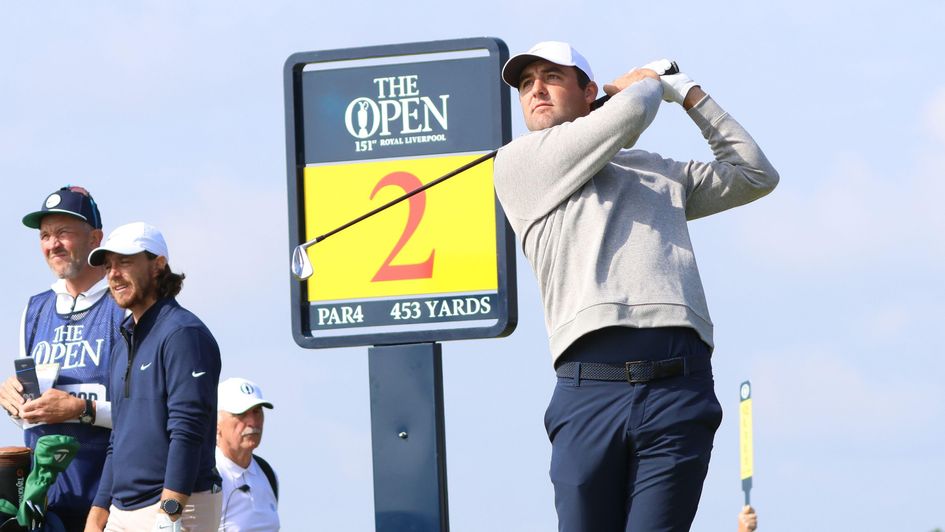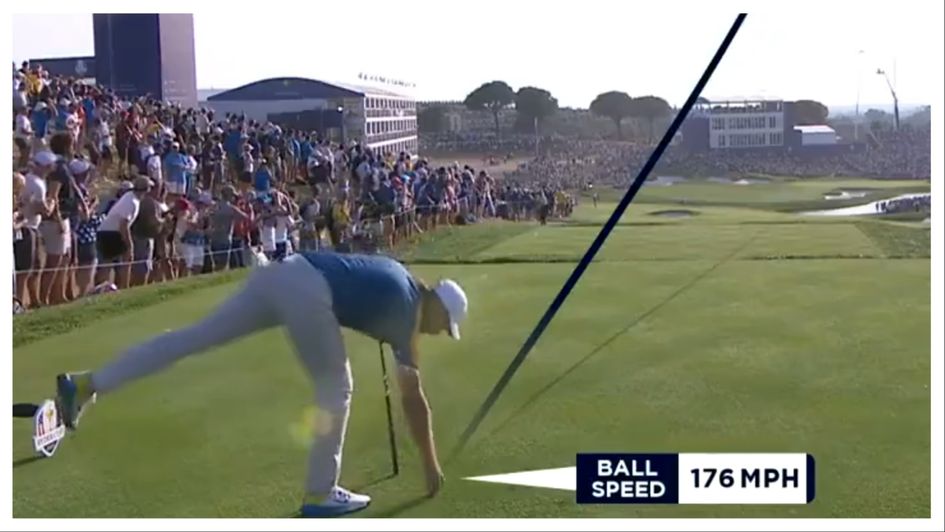 Fast Results
Fast Results Scores
Scores
The Open Championship: Ben Coley on the final men's major championship of the year
If the defining image of the previous generation is Tiger Woods' iconic punch of the air, then the defining image of this one will be something that takes a little more imagination.
The golfer isn't as important – take your pick from a dozen – and they're neither celebrating nor in full flight. This image is captured before they've completed the first shot on that hole, but after the swing. They're bending down now, to pick up a tee peg. The ball is about a third of the way to its destination, and its movement is being tracked by a bright-coloured line on the television screen.
The golfer didn't need to watch, because he knew from the moment he hit it that he could find his ball quite easily, by wandering down the fairway in front of him until around the 320-yard mark. It'll be there, somewhere. And if he's lucky, he'll be able to pop that very same tee peg back in the ground, pick up the adjacent ball, toss it to his caddie to have it cleaned, and replace it close to where he found it. Everything clean, everything clinical.

This is golf as we know it in the year 2024 and in May, it escaped the PGA Tour and made its way to Valhalla for the PGA Championship. There, some of the finest modern golfers bludgeoned there way into a thrilling Sunday conflict which ended with one of the most reliable PGA Tour players of them all, Xander Schauffele, a newly-minted major champion. He deserved it because he earned it and will forever be known as such. History won't, and perhaps shouldn't, waste time trying to shackle the details as they slowly escape.
That shouldn't stop us pondering a question which arrived in the aftermath, when it was suggested that Valhalla had tested players' skill to a higher degree than most courses, because the higher-skilled players stretched their advantage over those of lower skill. This is absolutely true, with one important caveat: these skill profiles which tell us who are the higher-skilled players rely almost entirely on tour golf. There is no other way to judge players than the tournaments they take part in.
I wonder though, what if? What if it so happened, because of forces beyond the sport's control, that golf had found its modern home in its original one, in the UK and Ireland? What if it so happened that the often claustrophobic courses of Japan, the high altitude of South Africa, the biting winds of Scandinavia, instead housed HQ?
And if that's all too hypothetical to be worth a moment's consideration, what if golf's custodians had acted quicker and limited the scope of club and ball technology? What if the size of the driver head had not been allowed to double? What if the Bridgestone Golf engineer who collaborated with Tiger Woods to change the game at the turn of the century had a different set of constraints within which to work?
There is a strong argument, purveyed by Woods and by Rory McIlroy, that players of their calibre would have benefited in the long-term (Woods, of course, benefitted hugely from technology changes in the short-term); that their ability, often described as 'natural', would allow them to separate when others are finding it harder to control spin with off-centre strikes. Few would argue with it – in some ways, this a sad reality of what we have instead.
It is nevertheless true that two conditions – where golf is played and what it is played with – have had an enormous effect on the sport as it is today. While unfair to categorise the PGA Tour as a collection of shootouts played across a rotation of near-identical courses, there are few which are not routinely overpowered. Only on a handful of par-fours, often thanks to some sort of hazard, are second shots played with more than a seven-iron. Golf courses are running out of ways to challenge players who are taught to swing hard and work on their wedge games.
And then, a month after the PGA Championship, along came Pinehurst's No2 Course. It shares almost nothing in common with the PGA Tour venues either side; Valhalla, almost everything. Balls bounced, left and right. They rolled and rolled and came to rest where they came to rest, long since beyond the control of the player who sent them on their way.
Scottie Scheffler talked about how uncomfortable it made him, the world's best and most comfortable golfer. It was by some way his worst performance of the year. Where on the PGA Tour, his small misses are minimised, here they could be magnified. That threat alone presented an almost entirely new challenge.
Scottie Scheffler said he found it hard to manage his misses at Pinehurst because of the wiregrass off the fairways.
— Paul Hodowanic (@PaulHodowanic) June 19, 2024
It messed with him on the tee, not knowing where to miss and that he could be perfectly fine or totally screwed depending on the lie. pic.twitter.com/RDE4fKku8J
How would Scheffler cope if this was normal? What would his career look like? Would he simply learn to become comfortable under these conditions, or would he be a less extraordinary golfer? In broader terms, would the kind of dominance he has produced even be possible? Could it be more common, whether through him or somebody else?
The evidence we have, while limited, tells a story. Scheffler's T41 in the US Open was his worst performance in a major since he was 23rd in the Open. That had been his first failure to reach the top 20 since the CJ Cup in October 2022, played at Congraree, which offers its own version of something different: short grass, undulating ground, an unavoidable sense of the unknown. Among his worst performances over the months prior to that were a missed cut in the Scottish Open, followed by 21st at St Andrews.
Scheffler is a generational talent and no mistake, but what he's best at is control: of lines off the tee, of distances with his approaches. It is the type of control that the PGA Tour allows its very best players to establish; the type of control that links golf and its cousins are always working to maintain. Whether or not Scheffler can overcome that will from here on be the most fascinating aspect of a Hall-of-Fame career, more so than just how many PGA Tour titles he can go on to gather up.
And it brings us to the Open Championship at Royal Troon where, in 2016, two players won that battle with the golf course. Henrik Stenson and Phil Mickelson, two of the finest golfers in the world, separated themselves because of a different type of skill, a type seldom tested, one they'd each had to carve out over time. I wonder what the numbers would have said back then, in the year of a PGA Championship at Baltusrol. Doubtless that with some lesser-knowns filling out the top 20, the impression would have been of skills undermined rather than emphasised.
No doubt, this is the major championship with the broadest range of possible outcomes. There absolutely is more randomness, more fortune; there are more bad shots unpunished, more good ones unrewarded. Every ounce of control must be earned, not often through hitting it harder or even swinging the club better, but by good choices, patience, acceptance. Perhaps simply by acknowledging that whatever you do, this still might not work out.
It is sometimes asked why modern golfers don't tend to show the creativity of old around the greens, reaching for one of their three or four wedges and getting the ball in the air. The answer is that it would be an inefficient use of time, because what they need throughout the year, throughout even some of the major championships, is to elevate the ball and then to make it stop.
When this kind of golf is four or eight days in a hundred, best to work with what you've got.
That's why Shane Lowry and Cameron Smith and Brian Harman have their names etched into the Claret Jug: because what they've got can in fact work best under this version of the sport. It's why the Open was where Darren Clarke defied time, where Mickelson was most proud to finally figure it out, where Stenson completed his career arc.
It's where golfers are asked questions to which there might be myriad answers, none straightforward, none part of their PGA Tour memory bank.
And so on Thursday, when one of these world-class golfers puts their tee peg in the ground and uncoils an athletic swing of biometrical perfection, informed by the coaches and the data, powered by the gym and the diet; when they strike that laboratory ball with the middle of the enormous club face and send it straight down the middle, something different will happen: nobody will be able to take their eyes off it.